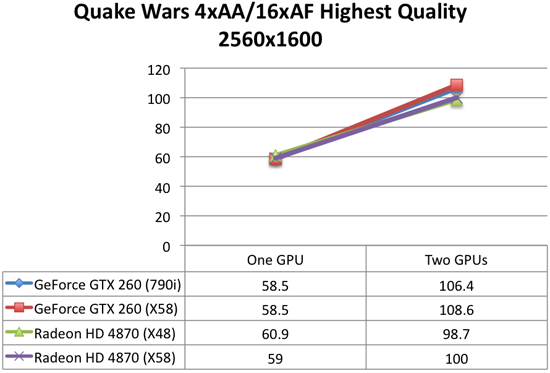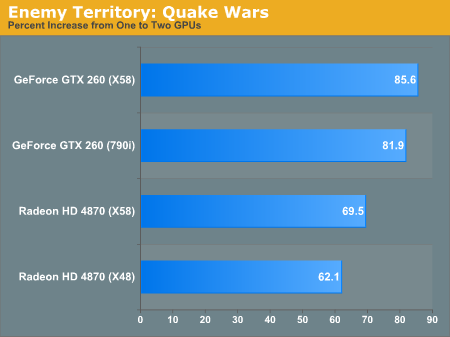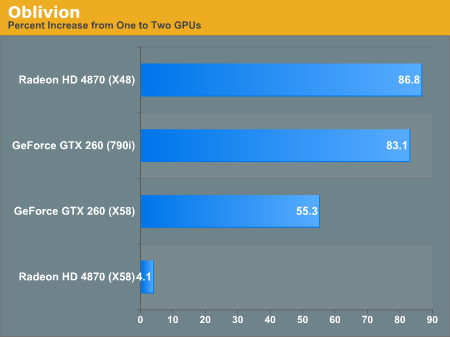The Dark Knight: Intel's Core i7
by Anand Lal Shimpi & Gary Key on November 3, 2008 12:00 AM EST- Posted in
- CPUs
X58 Multi-GPU Scaling
While we had some hope earlier in the year of unifying our SLI and CrossFire testbed under Skulltrail, we had to scrap that project due to numerous difficulties in testing. Today, we have another ray of hope. Having a single platform that will allow us to run both SLI and CrossFire would give us better ability to compare multiGPU scaling as there would be fewer variables to consider.
So we did a few tests today to see how the new X58 platform handles multiGPU scaling. We have compared CrossFire on X48 and SLI on 790i to multiGPU scaling on X58 in Oblivion and Quake Wars to get a taste of what we should expect. And the results are a bit of a mixed bag.


With Enemy Territory: Quake Wars, we see very consistent performance. Our single card numbers were very close to the numbers we saw on other platforms, and the general degree of scaling was maintained. Both NVIDIA and AMD hardware scaled slightly better on X58 here than on the hardware we had been using. This is a good sign that the potential for accurate comparison and good quality multiGPU testing might be possible on X58 going forward.
But there there's the Oblivion test.

Under Oblivion, NVIDIA hardware scaled less on X58, and our AMD tests were ... let's say inconclusive.

We have often had trouble with AMD drivers, especially when looking at CrossFire performance. The method that AMD uses to maintain and test their drivers necessitates eliminating some games from testing for extended periods of time. This can sometimes result in games that used to work well with AMD hardware or scale well with CrossFire to stop performing up to par or to stop scaling as well as they should.
The consistent fix, unfortunately, has been for review sites to randomly stumble upon these problems. We usually see resolutions very quickly to issues like this, but that doesn't change the fact that it shouldn't happen in the first place.
In any event, the past couple weeks have been more frustrating than usual when testing AMD hardware. We've switched drivers 4 different times in testing, and we still have issues. Yes, 3 of these four drivers have been hotfix beta drivers, but for people with Far Cry 2 the hotfix is all they've got, which is still broken even after three tries.
We certainly know that NVIDIA doesn't have it all right when it comes to drivers. But we really feel like AMD's monthly driver release schedule wastes resources on unnecessary work that could be better used to benefit their customers. If we are going to have hotfix drivers come out anyway, we might as well make sure that every full release incorporates all the fixes in every hot fix and doesn't break anything the last driver fixed.
The point of all this is, our money is on a lack of scaling under Oblivion due to some aspect of this beta driver we are using rather than scaling on X58.
As for the NVIDIA results, we're a little more worried about those. It could be that we are also seeing a driver issue here, but it just could be that Oblivion does something that doesn't scale well with SLI on X58. We were really surprised to see this as we expected comparable scaling. As the driers mature, we'll definitely test the issue of multiGPU scaling on X58 further.










73 Comments
View All Comments
Spectator - Monday, November 3, 2008 - link
that sht is totally logical.And Im proper impressed. I would do that.
you can re-process your entire stock at whim to satisfy the current market. that sht deserves some praise, even more so when die shrinks happen. Its an apparently seemless transition. Unless world works it out and learns how to mod existing chips?
Chukkle. but hey im drunk; and I dont care. I just thought that would be a logical step. Im still waiting for cheap SSD's :P
Spectator.
tential - Monday, November 3, 2008 - link
We already knew nehalem wasn't going to be that much of a game changer. The blog posts you guys had up weeks ago said that because of the cache sizes and stuff not to expect huge gains in performance of games if any. However because of hyperthreading I think there also needs to be some tests to see how multi tasking goes. No doubt those gains will be huge. Virus scanning while playing games and other things should have extremely nice benefits you would think. Those tests would be most interesting although when I buy my PC nehalem will be mainstream.npp - Monday, November 3, 2008 - link
I'm very curious to see some scientific results from the new CPUs, MATLAB and Mathematica benchmarks, and maybe some more. It's interesting to see if Core i7 can deliver something on these fronts, too.pervisanathema - Monday, November 3, 2008 - link
I was afraid Nehalem was going to be a game changer. My wallet is grateful that its overall performance gains do not even come close to justifying dumping my entire platform. My x3350 @ 3.6GHz will be just fine for quite some time yet. :)Additionally, its relatively high price means that AMD can still be competitive in the budget to low mid range market which is good for my wallet as well. Intel needs competition.
iwodo - Monday, November 3, 2008 - link
Since there are virtually no performance lost when using Dual Channel. Hopefully we will see some high performance DDR3 with low Latency next year?And which means apart from having half the core, Desktop version doesn't look so bad.
And since you state the Socket 1366 will be able to sit a Eight Core inside, i expect the 11xx socket will be able to suit a Quad Core as well?
So why we dont just have 13xx Socket to fit it all? Is the cost really that high?
QChronoD - Monday, November 3, 2008 - link
How long are they going to utilize this new socket??$284 for the i7-920 isn't bad, but will it be worth the extra to buy a top end board that will appreciate a CPU upgrade 1-2 years later? Or is this going to be useless once Intel Ticks in '10?
Strid - Monday, November 3, 2008 - link
Great article. I enjoyed reading it. One thing I stumbled upon though."The PS/2 keyboard port is a nod to the overclocking crowd as is the clear CMOS switch."
What makes a PS/2 port good for overclockers? I see the use for the clear CMOS switch, but ...
3DoubleD - Monday, November 3, 2008 - link
In my experience USB keyboards do not consistently allow input during the POST screen. If you are overclocking and want to enter the BIOS or cancel an overclock you need a keyboard that works immediately once the POST screen appears. I've been caught with only a USB keyboard and I got stuck with a bad overclock and had to reset the CMOS to gain control back because I couldn't cancel the overclock.Clauzii - Monday, November 3, 2008 - link
I thought the "USB Legacy support" mode was for exactly that? So legacy mode is for when the PC are booted in DOS, but not during pre?sprockkets - Monday, November 3, 2008 - link
No, USB legacy support is for support during boot up and for the time you need input before an OS takes control of the system. However, as already mentioned, sometimes USB keyboards just don't work in a BIOS at startup for one reason or another, and in my opinion, this means they should NEVER get rid of the old PS/2 port.I ran into this problem with a Shuttle XPC with the G33 chipset, which had no ps/2 ports on it. There was a 50/50 chance it would not work.